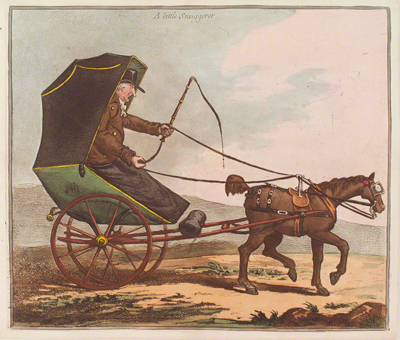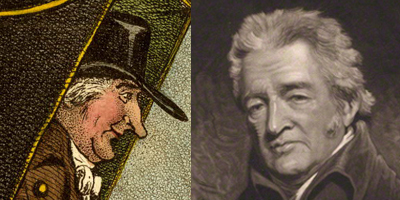A Little Snuggerer
Given the somewhat awkward perspective and the disproportionate size of the buggy to the horse, this print was most likely etched by Gillray based on the work of an unidentified amateur.

© National Portrait Gallery, London
One possible candidate for that honor is Francis Hawksworth (or Hawkesworth) of Hickleton Hall, who in November of 1799 wrote to Gillray to pay him for a previous commission for a print of Sir George Saville's tomb (BM Satires 9423) and to request his help with an etching of a man, a horse, and a buggy which he had already begun.
I have begun to try etching myself, but I am so defeated in the attempt that I must apply to you for a little assistance. . . . I have sent up by the mail coach of tonight a copper plate that has a very bad etching on it—some parts about the buggy are too strong, some parts by the horse are so weak as not to be seen in the impression. I would have destroy'd the plate immediately had not the face and figure of the man been so extraordinarily like him that I am sure I can never get such a resemblance again. Now I want you to cover the plate with wax and touch it up for me. I would be very happy to give you the same price for doing this as if you were to etch a new one. If the lines of the face are too strong, you must burnish them down, but not by any means alter the likeness. Pray get the plate cut off at the bottom just above the letters and make a couple of lines at the sides of the plate. I know I have imposed upon your hands a piece of drudgery, but I really shall by greatly obliged if you will make an attempt to make it look decent. The sooner you send it me down and the better with twelve impressions not coloured [sic]. Give my complements to Mrs Humphreys [sic].*
Your obed. servt. F. Hawksworth. Hickleton Hall near Doncaster.
Hawksworth was a Yorkshire man and amateur artist and patron of the arts. According to The Sportsman he was one of the first to recognize and encourage the art of John Frederick Herring, the "coachman painter," offering him a stipend to enable him to leave his coachman's duties and devote himself full time to his art.
But as his involvement with commisions for the [Tomb of Sir George Savile] in 1799 and the later Gillray print, Orange Jumper (1809) suggests, Hawksworth was also active in politics, supporting the general principles of Savile and the Yorkshire Association headed by Christopher Wyvill.
If Hawksworth is indeed the amateur behind A Little Snuggerer, and Gillray is simply "fixing" the plate for him, that may explain why the print lists no publisher or publication date. It was originally intended just for private circulation. And if Gillray made only a few extra copies in a colored version after returning the plate and twelve uncolored copies to Hawksworth, that would also explain why the print is relatively rare.
But if Gillray received the request in November of 1799, that would probably put the finished print in either late 1799 or early 1800 rather than 1801 as Dorothy George hesitantly suggests. There is only one other print from Gillray in December of 1799, and it is another single figure print and likely based on an amateur's work. So Gillray would almost certainly have had time to work on Hawksworth's plate in December.
Having speculated thus far, I may as well proceed to a very tentative identification of the man in the buggy. In his letter to Gillray, Hawksworth asks for twelve copies of the print which suggests that he intended to give them to friends for whom the portrait of the man would be recognizable and have some sort of significance. Twelve seems like a fairly large number, so it is likely the man would have to be widely known.
The Reverend Christopher Wyvill would seem a likely subject. Having just commissioned the Savile tomb, it would not be surprising that Hawkesworth would have Wyvill on his mind. Wyvill worked closely with Savile in the Yorkshire Association, and Wyvill was in many ways the successor his ideas. Wyvill would have been a vigorous forty-nine in 1799 at the time of Gillray's print, about the age of the man in Snuggerer. And given his politics, he would have been well known and well traveled among independent Yorkshire gentlemen like Hawksworth, and would not have disdained the simplicity and economy of a one-horse, one-passenger gig.
The only portrait of Wyvil was completed 10 years later, and it is not in profile. But there is similarity in the basic contour and expression of the Gillray and Meyer/Hoppner portraits and a common look of benevolence that makes the identification at least possible.

© Trustees of the British Museum
Detail of Henry Meyer, after John Hoppner
Rev'd Christopher Wyvill [1809]
© National Portrait Gallery, London
Sources and Reading
- Commentary from the British Museum on A Little Snuggerer
- Mathew Crowther, "I admire very much your etchings" — James Gillray's fan mail, The Printshop Window
- "Christopher Wyvill," Wikipedia
Comments & Corrections
NOTE: Comments and/or corrections are always appreciated. To make that easier, I have included a form below that you can use. I promise never to share any of the info provided without your express permission.